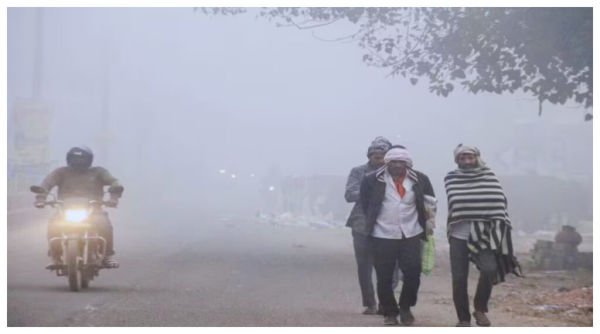Summary: Konkan’s famous Amboli recipe: Taste of home in every bite
Amboli is a traditional and very soft pancake from Maharashtra made from a fermented rice-lentil batter. Its taste is heart-winning for breakfast, festivals and special occasions.
Maharashtrian Amboli Recipe: Today we are going to make a very tasty and traditional dish of Maharashtra, Garam Garam Amboli. Amboli is a type of pancake, which resembles dosa but has a slightly different taste and texture. It is a favorite for breakfast in Maharashtra and is often eaten with coconut chutney, potato bhaji or any spicy gravy vegetable. It is very easy to make, it just takes a little time because the solution has to be left to ferment. But trust me, the wait is totally worth it!
story of amboli
Amboli is not just a dish but a part of the culture and tradition of Maharashtra. It is especially popular in the Konkan region of Maharashtra, where rice and coconut are used extensively. The word Amboli comes from the Marathi language, and means a thick and soft pancake. In ancient times, women in homes would wake up early in the morning to make Amboli with fresh batter, and its hot taste would spread throughout the house. This is a dish that has been made for generations, and is still prepared with the same love and enthusiasm. It is also often made during festivals and special occasions, and its taste brings a smile to everyone’s face. It’s a comfort food that makes you feel at home.
- 1 cup Rice About 200 grams parboiled rice
- ½ cup urad dal without peel
- ¼ cup Chickpea lentil
- 1 spoon fenugreek seeds
- Salt as per taste
- Water to grind and dissolve
- oil/ghee to bake amboli
Step 1: Soaking the Rice and Dal
-
First of all, we have to wash the rice and dal thoroughly. Combine parboiled rice and regular rice together in a large bowl. Wash them with water 3-4 times until the water looks clear.In another bowl, add urad dal and chana dal together. Also add fenugreek seeds to it. Wash lentils and fenugreek seeds with water 3-4 times.Now, add enough water to both the bowls and leave them to soak for at least 6-8 hours or overnight. This will make the rice and lentils soft and easier to grind. Soaking also helps in the fermentation process.
Step 2: Grinding Rice and Lentils
-
When the rice and lentils are thoroughly soaked, take them out of the water. Throw away the water. Now we will grind them.First put lentils and fenugreek seeds in the mixer grinder. Add some water to it (about ¼ cup) and grind until a smooth paste is formed. Try not to add too much water, we want a thick batter. While grinding, stop occasionally and scrape the edges so that everything is ground well. After the lentil paste is ready, take it out in a big deep vessel.Now add soaked rice to the mixer grinder. Add some water to it (about ½ cup) and grind it until smooth. Rice can be ground a little coarser than lentils, but it should not be too grainy. After the rice paste is ready, mix it in the vessel containing the pulses.Remember, consistency of the solution is very important. It should not be too thin, otherwise it will be difficult to make amboli. It will be slightly thicker than the dosa batter.
Step 3: Leaving the batter to ferment
-
Now mix the ground rice and lentil solution together well. You can use your hands as this helps promote the fermentation process (the warmth of your hands and the bacteria). Beat the batter well for at least 5-7 minutes so that air is incorporated into it. This will make Amboli soft and fluffy.Now add salt to this solution and mix well once again. Now cover this vessel with a lid and leave it in a warm place for 8-12 hours or overnight to ferment. It may take more time in winter, and less in summer.Once the yeast has risen, the batter will double in volume and have a slight sour smell. Small bubbles will also be visible in it. This signals that your batter is ready to make amboli!
Step 4: Making the Amboli
-
Now that your batter is ready, it’s time to make the amboli!Heat a non-stick tawa or iron pan. When the pan becomes hot, reduce the flame to medium. Pour some oil or ghee on the pan and wipe it with a clean cloth or half a piece of onion. This will prevent the emboli from sticking.Take a tablespoon (or ladle) of the batter and drop it into the center of the hot pan. There is no need to spread the batter much, Amboli is not as thin as Dosa. Leave it a little thick. If you want, you can spread it a little with the back of a spoon, but not too much.Cover the pan with a lid and let the amboli cook on medium flame for 2-3 minutes. By putting the lid on, the Amboli gets cooked properly in steam and becomes soft.
Step 5: Flip the Amboli and Serve
-
When the amboli is cooked on one side (you will see small holes and dry edges on the top), remove the lid. Add a little oil or ghee on the sides and top of the amboli. Now carefully turn the amboli with the help of a spatula.Let the Amboli cook from the other side for 1-2 minutes until it turns golden brown. Amboli is not very crispy, it is soft and slightly fluffy.When Amboli is cooked well from both the sides, remove it from the pan and take it out in a plate. Similarly, keep making Amboli from the remaining batter also.Your hot Maharashtrian Amboli is ready!
Tips and Tricks
Perfect consistency: The consistency of the solution is very important. If the batter is too thin, the amboli will not spread and will become very crispy. If it is too thick, the amboli will become hard and thick. Ideally, it should be slightly thicker than dosa batter, but spread easily.
Importance of Temperature: Room temperature is important for the fermentation process. In hot weather the batter ferments quickly, while in cold weather it takes longer. If it is very cold in your house, then turn off the oven and keep the solution inside the oven (the oven should be turned off!).
Fresh solution: Always use freshly ground solution. If you refrigerate the batter for a long time, the fermentation process will slow down and the amboli will not become as puffy.
Non-Stick Tawa: Non-stick tawa works best for making amboli as it does not stick. If you are using an iron tawa, make sure it is well ‘seasoned’ and cleaned with a little oil before making each amboli.
Use of lid: By cooking Amboli by covering it with a lid, it gets cooked properly from inside and becomes soft and spongy. It is not crispy like dosa.
Oil/Ghee: Using a little oil or ghee while roasting Amboli cooks it well and also tastes good.
Storage: If you have leftover batter, you can store it in an airtight container in the refrigerator for 2-3 days. When you want to make Amboli, take the solution out of the refrigerator and let it come to room temperature and then use it.








